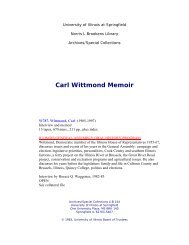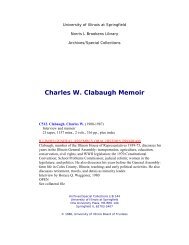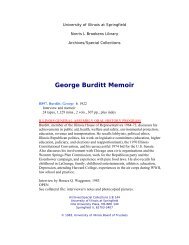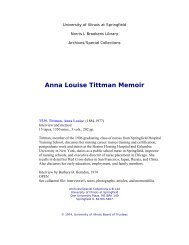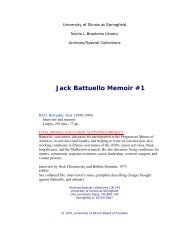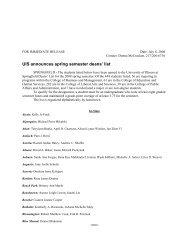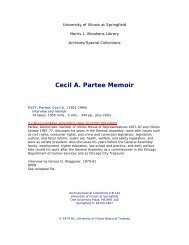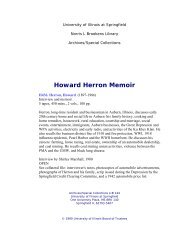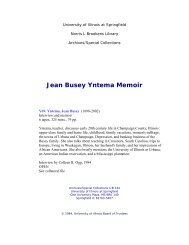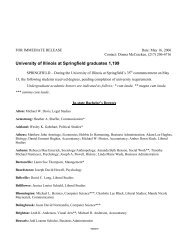Leland J. Kennedy Memoir - University of Illinois Springfield
Leland J. Kennedy Memoir - University of Illinois Springfield
Leland J. Kennedy Memoir - University of Illinois Springfield
Create successful ePaper yourself
Turn your PDF publications into a flip-book with our unique Google optimized e-Paper software.
Q: Pawnee has a big mine.<br />
A: Yes I guess so, sure. Virden, Virden, we'd go through Virden, but whether there was<br />
a siding there I don't know, but all <strong>of</strong> those towns in my beginning <strong>of</strong> a career in <strong>Springfield</strong>,<br />
were on the <strong>Illinois</strong> Terminal. You could go on the <strong>Illinois</strong> Terminal to <strong>Springfield</strong>, but you<br />
had to go to Granite City to catch it, or over to - you could go out to Hamel there at -<br />
I have done that but very seldom.<br />
Q: I notice the Pevely is a big granary, is that?<br />
A: Well, it's Pevely Mill, it used to be. Now, in my younger days there was a Sparks Milling<br />
and the Standard Tilton Milling and if memory serves me correct, the present Pevely dairy,<br />
or mill, is an outgrowth <strong>of</strong> Standard Tilton-Sparks. They were all merged you know and<br />
I guess as they modernized their equipment and their exports and imports declined, or rose,<br />
they merged those two mills. That's where they were. The Sparks Milling Company is the<br />
<strong>of</strong>fice still sits there.<br />
And there used to be an old prison in Alton, an old Confederate prison down there. You<br />
mentioned Pevley Mill, why, you passed the - maybe a mile, it couldn't be - the river runs<br />
east and west in Alton, and a mile or maybe a half a mile up the hill there, when you look<br />
up the hill - you come up the road, if you look up there when you go by Pevely, there's<br />
an old - it could be a parking - it's a parking lot now. That's the site <strong>of</strong> the old Confederate<br />
prison in Alton.<br />
But how many inmates they had there or not, I don't know. There is a well-kept Confederate<br />
graveyard and monument out here on Rosher Street in North Alton that would be<br />
worth your tour, sometime when you're over on this duty for the university, to look into<br />
that because I don't think too many people know it's there. But it's well-kept. It evidently<br />
has a caretaker. It's very accessible, but my wife and I just were riding around here, oh,<br />
one time this summer and she wanted to find out where somebody lived and we were out<br />
in that area and I - oh it was a school - it is taught in the Alton schools. You've got<br />
the Lovejoy monument and they have a federal cemetery over by the Lovejoy monument,<br />
it's a federal - hut I think it's full. I don't think they're taking any more graves.<br />
Q: I suppose the federal government takes care <strong>of</strong> the place?<br />
A: I think so. They have a caretaker and I suppose they take care <strong>of</strong> the Confederate too,<br />
it's wcll-kept. Who the caretaker is, or how it's taken care <strong>of</strong> I don't know, but I don't<br />
think many people - I doubt if it's taught in schools. We were taught that in schools, that<br />
it was there.<br />
Oh, and Hartford had a tannery. Hartford Tannery. A lot <strong>of</strong> girls worked there during<br />
the war, out <strong>of</strong> high school or just before they were going to get married, from prominent<br />
middle-class families there, well-to-do and just ordinary citizens. It was a big plant, the<br />
tannery was, and they - well there was a seven-day operation around the clock. It's closed<br />
now, but during the war it was - the Watkins family, he was the manager and in fact<br />
this Levinson who just died, his wife was a Watkins, and her father was one <strong>of</strong> the big shots<br />
in it, or one <strong>of</strong> the executives in it. I shouldn't say big shot, that sounds like a street name,<br />
but he was an executive in it.<br />
We have a family out here, his father was an executive in it. And I mentioned that my<br />
mother took in roomers and boarders and when the tannery first started, and I was still<br />
in grade or high school, my mother had several tannery executives before they could get<br />
housed. They didn't stay that long, maybe four or five or six weeks, or something like<br />
that. But different women had their name on that list down there to have - you know,<br />
that's the way boarding houses are done, or rooming houses or whatever you would call it,



